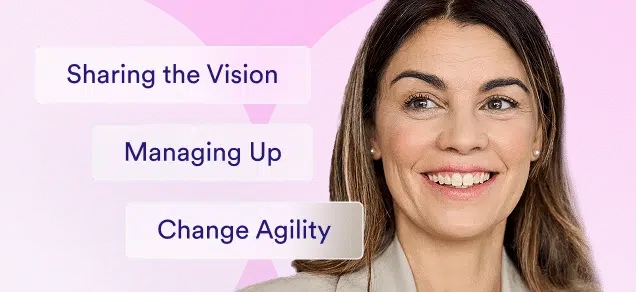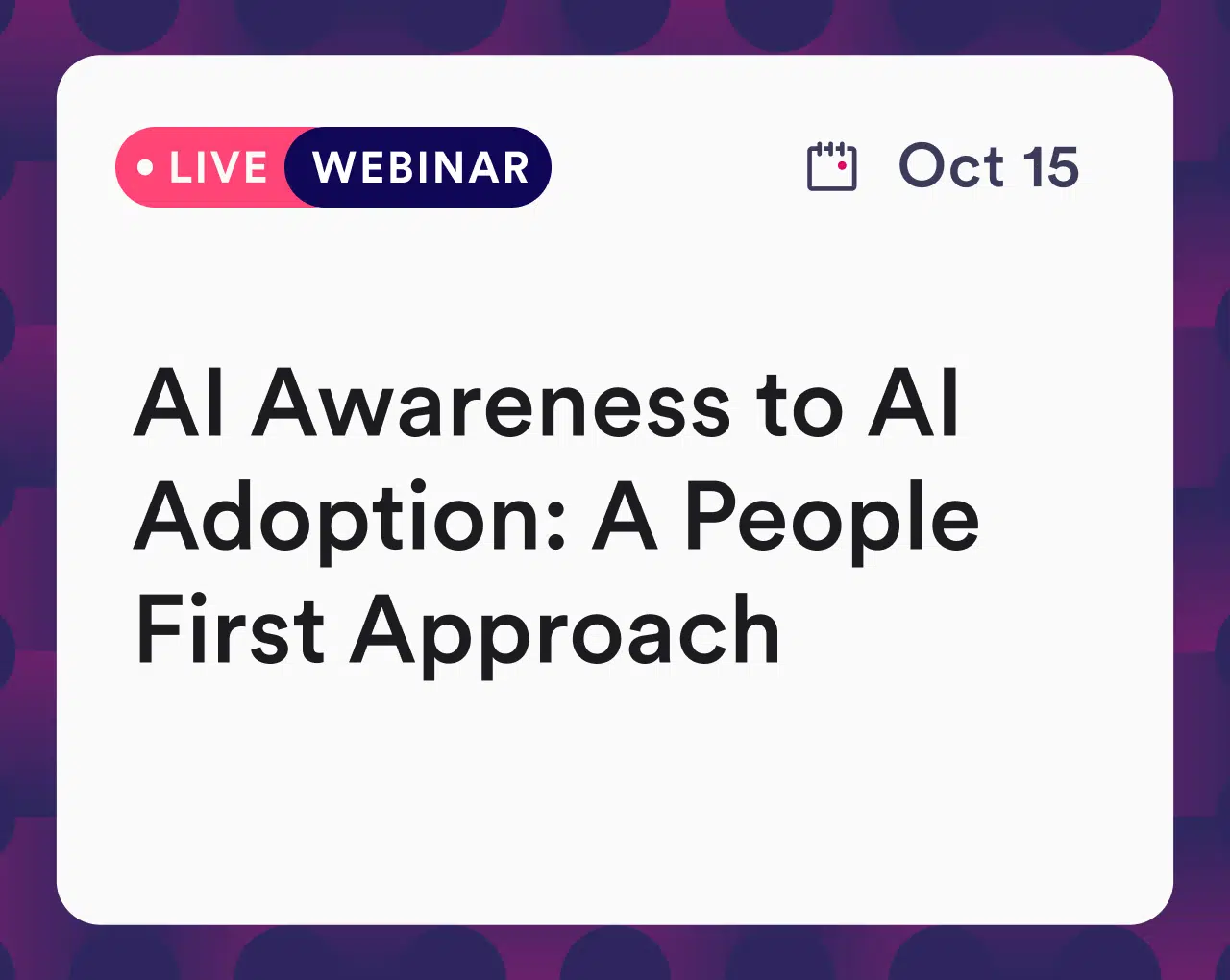Tom Griffiths
I'm thrilled to have the opportunity to showcase some of the work that we've been doing with the Josh Bersin company, and Course Hero. Really excited to introduce Josh and Nehal, and Vicki, and I'll give them formal intros in a moment. My name is Tom Griffiths, I'm the co founder and CEO of Hone. And just to set some context for who we are and what we're doing here today. We started Hone about four or five years ago, really with a vision of reimagining what corporate training looks like, for the modern workplace. I built a previous company in the gaming space called FanDuel and really seen that there was not a great solution for things like people skills, leadership and management skills. And we were really stuck with two choices. It was either the scalability of elearning libraries that really do scale to the whole organization, but actually aren't that engaging or transformative when it comes to behavior change. Or on the opposite end of the spectrum, there was classroom learning, where you fly everybody into a location or a hotel ballroom, do a training session for a couple of days with a flip chart, and then send everyone back to the workplace. And again, that can be an engaging experience, but really difficult to scale. And so we founded Hone, really on the basis of this new mode of education, which is live online cohort based learning, so that we could get the best of both worlds, scalable to everyone and typically a distributed or hybrid workplace, but also highly engaging. Because it's interactive, it's small group taught live with a coach over multiple weeks to really drive behavior change. So I'm really excited to dig into that, and share some of the work that Josh and the team have done with Course Hero, and just show the impact of that modality. We've been partnered with Josh, for a few years now he's been an advisor to the company for for a while. And our joke is that, you know, even though my background is technical, what we're trying to bring back to the space is that human touch, it's hard, even with all the automation and AI that we have hard to be a real genuine human interaction and kind of coach, student dynamic. So we let the humans do what the humans do best, which is the teaching and the interaction, the feedback and the coaching. And we also have a technology platform that helps to scale that to, you know, hundreds of 1000s of learners at an organization. That kind of training, it really fits well for leadership. And that's what the report is on today. You know, we're typically known for our leadership and management content. But we also have made a big investment over the last three years in DEI. And that's actually the content that we'll talk about with Vicki and Course Hero So before I pass it off, let me formally introduce our panelists, Josh Bersin who I think needs no introduction, our global industry analyst and president and founder of Bersin associates, which includes the Bersin Academy, the Josh Bersin company, and research and analytics Think Tank, that we all follow religiously in the space. So welcome, Josh. Now, Nehal Nangia works with Josh at the Bersin Company, as the director of research, and she's been a fantastic partner over the last year as we put together this report, and as the primary author of that. And then Vicki, Vicki Choi, with Course Hero, VP of HR, she has been our first case study for this report, I want to share a little bit about how Course Hero have deployed Hone and our DEI training to create some fantastic results that Course Hero later in the session. If you have questions as we go, feel free to drop them into the Q&A feature, and then we'll get to Q&A about 10 minutes before the end. With that, I'm excited to hand it over to Josh in the house to take us through the report, the new model of live cohort based leadership development. Josh now over to you.
Josh Bersin
Thank you, Tom. Let me give you guys all a little bit of context. I entered this space in the year 1998. Believe it or not, when there was no online anything. And all training was done in a classroom. And of course, what happened was, we thought the internet was so cool. We tried to replace everything we had ever done in a classroom on the internet with this thing we call the learning. And over the last 20 years, there has been video based elearning collaborative collaborative elearning microloan are they learning in the flow of work. And then of course, you know, Twitter, Tik Tok, YouTube, and all of the manifestations of that, that lead to more and more types of technology based training. But lo and behold, one of the most important ways people learn is by talking to and interacting with others and with an expert. And that is why universities and executive education programs, and many, many live education institutions remain very popular despite all the internet. And what happened three or four years ago when the pandemic started. And I met Tom, zoom, and Microsoft Teams. And WebEx suddenly became ubiquitous, you know, you could do video based online learning before that, but it was kind of clunky, and it was kind of slow, and it's kind of expensive. And there are always glitches, it's this guy can't get in or that guy can't get in, or this works, or that doesn't work. And there were special virtual classroom systems designed for this years ago, that they weren't very good. But now we have this technology, we have this bandwidth, we have ubiquitous internet access. And so live is back. And it's turning out that for mastery based learning in soft skills, we call it power skills, leadership, management, diversity. And by the way, we're all leaders, everybody in business is a leader at some point in their job and their career. So everyone needs these skills, not just people that are moving up the corporate hierarchy. You know, human lead, instructor led live learning is extremely valuable. In fact, I think, as I wrote in the article that I promoted just last couple days, most of the mastery oriented new learning platforms are more like Hone, and much less like Skillsoft or LinkedIn learning. That's not to say self study stuff isn't is. there's anything wrong with it. But it just doesn't touch. You know, the the issues that come into when you have to change your behavior and need to think about yourself differently and examine how you react to certain things and go through a simulation and be challenged. So my hat's off to Tom and the Hone folks, for building this. And let me turn it over to Nehal who tell you more about the story. Nehal over to you.
Nehal Nangia
So taking my cue from a lot of what Josh said, we are at a time when leadership has never been more important. We're in the middle of high turnover rates, labor shortages, and the need to sustain business growth in a tightening economy. Amid all of this organizations lean on leaders and recognize the need to build more leaders at every level in the organization. The challenge this poses for L&D functions is that balancing personalization and scalability and also cost and impact. A plausible and promising solution to this challenge is a new approach live covert based leadership development. And that's what we'll talk about today. But to get us started, I'll begin with the macro context of where we are and why leadership and the topic of leadership development is so pertinent today. This is where we are at right now. The economic growth that picked up in 2008 was interrupted by the pandemic causing the supply chain problem we have with skills and Development and Job redesign going on through the current cycle. Overall, we've had a growth cycle that lasted almost 15 years. And now we're sort of at a late stage economic growth when the economy is still growing in many countries, but it is slower economic growth, job creation is also slowing down. But we're still creating new jobs just not as many as we were last year. There's over 160 million people working in the United States, and there's over 10 million jobs open. One out of 15 jobs roughly are empty today, which means people are moving between roles and jobs at a rate we've never seen before. Quit rates continue to be high and unemployment rates continue to be as low as three and a half percent in the US. Now this slide only shows us labor data. But this is true globally, where choices and open jobs are way too many and hiring people is still harder than ever. And what this means is we're likely to have a slowing economy and still a very difficult labor market. Over 4 million people are quitting their jobs every year, which is more than a third of the workforce. There just aren't enough Have people outside to fill those jobs? What that means is, organizations need to engage, nurture and build that talent internally, you need to help your people build new skills and grow in new ways you need to facilitate growth in new roles, better careers growth as emitters. But first, and most importantly, you need to hold on to your talent and keep them from quitting. We wanted to understand what keeps people from quitting? What is it that has the highest impact on driving engagement and retention, and creating an employee experience that will make people stay. So we did this enormous study on employee experience, we study close to 100 practices that impact employee experience. And here's what we saw. These are the top 15 most impactful practices and if you look closely, you'll see those yellow icons dominating all over which are all practices related to trust in the organization. 10 out of the 15 most impactful employee experience practices have to do with trust in the organization, transparency, empathy, integrity of positive and inclusive work environment. Bottom line is, people today need to trust the organization. And this context is extremely important for our webinar today, because in every organization, it is leaders that are the vehicle for building trust in the organization, especially in a volatile business environment today making the topic of leadership more important than ever before. Okay, what's also happening simultaneously is there's a massive reinvention of industries which is happening, healthcare companies are turning into data and informatics companies, retailers are turning into pharmacy and medical service providers. Oil companies are turning into solar and electric energy companies, telecommunications companies are becoming media companies. And automobile companies are becoming electric propulsion, battery software and data companies. In almost every industry, businesses are constantly transforming. And they need new skills, new roles and new organizational models to survive. Meaning that today, businesses more than ever before, meet people who are committed and willing to go along on the journey, a workforce that feels supported in building new skills, and we need people who trust that they have a future with the company. Now to build the right skills, you need the right leaders to build trust and belonging and to engage and retain talent through all this transformation and disruption. You need the right leaders to build the right operating models and even to build future leaders. You need the right leaders and guess what leaders are stressed. And leaders are also leaving at rates unlike ever before. Our research tells us that organizations are just not prepared and worse. The percentage of organizations who are prepared or believed that they weren't prepared has also gone down in the past three years. When we asked over 8000 HR professionals through our capability assessment project, only 11% said they have the capabilities needed for what it takes to build the right leadership models and to articulate the skills that really matter. Less than a third of these 8000 HR professionals said they have the capabilities to develop leaders effectively. So how do we change that? One of the reasons why leadership development efforts are in flux today is because they're largely focused only on leaders. And that does not surface. Here's why. The numerous interconnected illuminated patterns that you see on the right side of my slide, that is a very close visualization of how organizations operate today. Those sticks in boxes are on charts that we've all seen and used. They hold good on paper. But that's not how businesses operate. Today. Almost 80% of organizations today operate a smaller, flatter, highly interconnected and empowered networks of teams. And teams. People need each other, they collaborate, they make decisions, they improve each other's performance, they influence each other and they get work done, which makes everyone a leader in their own capacity and contribution. Leadership today is a capability that permeates throughout the organization. It's a muscle that every individual in an organization needs to build not just positional leaders, and a lot of forward thinking organizations are embracing this shift in the definition of leadership. Fico, for example, is the leading applied analytics company they define leaders as anyone who inspires excellence and they invest in building leaders at all levels in the organization. For know what is leaders are not bosses, but people who listen more and talk less, who help build an inspired and curious organization. It's people who support the team, not people who have a team to support them, and what is wants to build an entire arm based organization. And another great example is of Lego, the building blocks company, they define leadership as the act of creating a safe space, like a playground, where everybody feels energized every day, making leadership, a capability for everyone in the organization, not just leaders. And this is a significant mindset shift, not just for HR and l&d teams and how you develop leaders and who you develop as leaders, but also in the mindset you want to inculcate in your leaders. So what exactly is the right mindset? You need leaders who will prioritize people over processes, purpose over profits, effectiveness over efficiencies, and always design for what is good for the people, not just for the business. It is what we refer to as human centered leadership. Now, you might wonder that there is no such thing as leading without thinking about humans. But every single leadership situation decision meeting, and every behavior that a leader activates at work can be thought of as two parts. There's the business part, what is the decision or action that we need to take to improve the performance of the company or team or product, whatever that is? And then there's the human side? What can we do? Or should we do to make the team more effective, to make the individual more effective, to help them learn to give them an environment where they can innovate and grow. And what we learned, especially from the pandemic is that during good times, you can focus on the left, but during uncertain and stressful times, during times of transformation and change, you have to focus on the right. It's the companies who focus on the people. First, there are companies that survive and thrive through transformation and disruption. Organizations today need to support leaders and teach them how to be more empathetic, more sensitive and more inclusive than ever before. You need to teach your leaders how to be sort of better psychologists is part of the leadership manifesto. And you need to teach your leaders how to care because believe it or not, the number one reason why people lead is having leaders who don't care. Human
Centered Leadership is essentially a mindset as I said before, it is an intention and the skills that are behind it, and how leaders need to act and behave, or what we call the power skills of leaders. In the old days, if you looked at leadership models, they would typically talk about things like customer centricity, innovation, execution, accountability, teamwork, they're all important, but they don't necessarily create behaviors. They tell you what you need to do, but are less about how you act and behave. The leadership capabilities that matter today are what we call power skills. And to give you some context on where these come from, there's a group at UC Berkeley called the Greater Good Science Center. And this particular group studies happiness, and they've defined characteristics of words that create happiness, which are some of the words you'll see on my slide. These are the power skills that we need to assess and develop in our current and future leaders. These skills are what matters most. But yes, they're not enough without the foundation of the right functional skills or business acumen leaders can't drive impact. functional skills are foundational and power skills are what differentiate talent, business and innovation outcomes for your organization. So the question is, how do we build these power skills at scale? Power skills are essentially human skills which are not soft skills. In fact, these are very hard skills to develop. Power skills are developed over time, and are strengthened through experiences interactions with experts and peers, and an amplified in group settings where people can challenge each other and create opportunities to apply and practice. To develop these skills. You need programs and content that span across time and across various topics. You require solid foundation and research you need expert facilitators, you need to create an environment where individuals can have intimate conversations healthy debate and challenge each other as they strengthenstre these skills. Now if you develop these programs in house, they can cause a significant drain on any company's resources. Self Directed or elearning content is not driving back because it lacks interactivity and collaboration. Also, with today's largely remote and distributed workforce doing these In person is not a feasible solution. The missing middle ground is where life cohort based leadership training solutions like Hone can drive massive ROI for your organization. Live cohort based training solutions bridge the gap between broad based general learning and specialize in person development programs which are personalized but not scalable. These solutions design and facilitate programs based on content that is researched, tried and tested across 1000s of learners and we replicate the elements of personalized classroom trainings in a collaborative small group and digital environment. Ultimately, helping organizations build these power skills and scale. Let's face it, live training is how we've always known training and there is no substitute for a fantastic teacher, facilitator or expert when you want to learn. We always associate our most memorable learning experiences with a very inspiring teacher or a great group of learning peers, or both. These solutions bring those same experiences to life in a virtual setup. And those are the kinds of learnings that drive the impact and outcomes to the business. As you can see on my screen, organizations that use the model of live cohort based leadership trainings have 20% lower turnover 46% higher leadership quality and fill roles 23% more quickly. One thing to keep in mind is that this model is not about one and done trainings, but continuous learning journeys that span several months. They include learning modules that are spaced out and interspersed with practice labs coaching and mentoring opportunities. work assignments are simulations, exposure to executives, community forums that allow ongoing discussion with your learning cohort peers, and they're meant to build long lasting relationships and drive long term behavior change. And platforms that offer this model of learning are also optimized to alleviate the administrative burden off of L&D departments to say schedule, track follow up or generate analytics on learner engagement and retention of learning. As part of this research, we actually spoke with several organizations who are taking advantage of these new age live cohort based digital learning solutions. And in our conversations, we came across a variety of use cases and functionalities so let's talk about some of those that really stood out. Most importantly, knowledge sharing and collaboration which is at the heart of cohort based experiences. When people collaborate, they learn better. Next is essential management training where the essential skills are skills like communicating effectively, managing difficult conversations, managing biases, etc. Leveraging external experts for these training frees up capacity for L&D teams to focus efforts on skills that are unique to the context of the business and cannot be outsourced. It also gives employees access to experts who do this as a profession and therefore provide curriculum based on extensive research that is validated across 1000s of learners. Next is inclusion training, which is by far the most common use case of group learning and development. These trainings, often centered around sensitive topics, and what we've seen is receptivity to the learning is typically higher when you bring in external facilitators, one of the reasons being that there are relatively lesser preconceived notions associated with the instructor. For example, if I do not consider a leader in my organization inclusive, which might just be my subjective belief or bias, I am less likely to be receptive to their wisdom around inclusive behaviors, whereas that's less likely to be the case with an external instructor. These solutions are great for customized soft skills training because they allow you to tap into huge networks of coaches and facilitators across regions and countries and they typically have the ability the ability to customize content for region specific as well as company specific news. These platforms offer an integrated learning experience by integrating coaching into the company's existing leadership development programs, and they also integrate with the HRIS and LMS, which makes tracking reporting and analyzing participant metrics and effortless exercise. Finally, these platforms are great for assessing and evaluating training effectiveness, most drew coaching and cohort based training members and pre and post assessments and sophisticated measurement instruments. They typically work with companies to determine a cool off period, after which they measure the impact, behavior change and retention from learning allowing companies not only to drive impact, but also measure and substantiate the impact of their investments. Life covered based trainings are the new model for scalable and engaging leadership development. They allow an inlet for external expertise around critical human skills, and an outlet for workers to share and learn from experts in a safe and stimulating environment. We saw in our research that the impact of this approach correlates with critical talent and business outcomes like career growth, innovation and helping employees unleash their full potential. Before I wrap up, I'll talk a little bit about one of these organizations we spoke with which is Course Hero, and you will also hear from Vicki directly later in the session today. So of course, Hero wanted to establish a common understanding around dei behaviors across the organization, not from a mandatory training perspective, but to ensure that the people were cared for. They wanted to bring people together in level set everyone on the basic definition and expected behaviors also in line with their new dei strategy. So they needed to do this at scale for everyone in the organization. They brought in Hone as their strategic partner and worked with them to define the size and composition of employees and managers, cohorts, manager cohorts, particularly defined to be small group no more than 12 to 15. Managers in each cohort creating room for candid conversations and knowledge sharing. They did not make it mandatory for employees, which is great because mandatory AI training often does more harm than benefit. They deployed Hone's DEI fundamentals training modules and ran 300 people through the program, they started to see outstanding results within six months most significantly, they were able to move up their belonging score by five percentage points, which is tremendous.
With that, let's bring it home with a quick recap of where we started on the topic of leadership itself and how leadership has evolved from positional leadership to leadership based on connections and contributions that individuals make the shift from leadership as a capability just for people, managers or executives to a capability that permeates across every career level and role. Irrespective of whether you have people management responsibilities. Leadership today is not limited to business knowledge instead leans heavily on people knowledge, well, leaders truly believe that taking care of your people comes first and only then will people take care of the business and make it right. Leadership today is a reflection of how businesses operate, shifting from command and control to inspiring excellence empowering teams and unleashing performance. It is these human skills or power skills that differentiate outcomes. And leveraging core based leadership development solutions is a way to strategically build these skills through experiences exposure and access to leadership experts in a scalable and engaging way. One final second for a super quick plug. They just kicked off our biggest ever study on irresistible leadership. What we're trying to unpack is what most organizations are struggling with today, which is how do you operationalize leadership models, institutionalize leadership behaviors? And how do you create accountability for these behaviors. So join us I'll drop the survey link in the chat. And by participating, you will also get early access to our research insights later this year. Thank you. And now I'm looking forward to a nice chat with wiki. Let me stop sharing. Hello, Vicki. I'm going to take a quick pause. Josh, any comments? Any thing you want to chime in before Vicki and I take over?
Josh Bersin
Well, I just as I was listening to you speak, I was realizing that, you know I've I've sort of dealt with this issue of leadership development for decades, it's a never ending problem. And every time a new solution like Hone comes along, you have to look at it because the impact is so high. And the problem is so continuous that you will always find applications for it. So thank you Nehal, I thought you did a really good job of putting a context around what the big issues are right now. And you know, please put the link out in there so people can join the research study, because I think that would be great. I'll turn it back over to you.
Nehal Nangia
I'm happy to do that. And again, thank you, Tom and the Hone team for your great partnership and collaboration on this study. All right. And part of that collaboration was some interviews that we did with Course Hero and Vicki. Thank you for sharing your great story and we've also written about it but for the benefit of people who are dialed in today. Let's kick us off with a little bit about you yourself. You Your organization and your role.
Vicki Choi
Sure. Thank you so much, Nehal. Great presentation. I think I also learned a lot with the research that you presented. And so Hi, everyone. My name is Vicki Choi, and I'm the VP of HR at Course Hero. Course Hero is also an online learning platform. But we focused on core specific study resources for an early university level students. And so our mission is to really help students graduate be competent and prepared. And I've been at Coursera for about 12 years now. So really kind of seeing the company grow from a small company to midsize company. We're around 300 employees right now. And so a lot of what Hone is doing was a pretty good match for our company at this time.
Nehal Nangia
Wonderful and to set some broader context. Tell us a bit about your DEI strategy. And what is your role within DEI and how Hone it fits into that landscape?
Vicki Choi
Sure, yeah. So we started our journey of investing more in DEI a couple years ago, in 2020, when there was quite a bit of social and racial issues going on at that time, and like Nehal you presented in your presentation, during hard times. And during times of transformation, it is really important for companies to focus on the human side, and making sure that employees feel like they have a safe space, feel like their workplace is somewhere where they can also get support that they need. And kind of going through a lot of the things that everyone has experienced over the past few years. And so our intent was really to make sure that employees felt a sense of belonging and inclusion at core zero. And so we implemented a DEI Task Force to really come up with a DEI mission, which is really centered around recognizing and embracing the diversity of each other's personal stories, experiences, thoughts, really built on a foundation of trust with each other. So that in turn, they would be able to collaborate better, make sure that there was inclusive conversations that were going on. So that was really the impetus for us to start our DEI efforts. And a little bit about our strategy. With DEI. Obviously, there's multiple factors that go into DEI. It's a very, very broad topic. And so for us, to help us really guide what we wanted to do for course, hero, we actually created three different pillars. And so one pillar being the workforce, how do we recruit, develop and retain top talent with diverse experiences? The second pillar being the workplace, how do we educate? How do we promote and also communicate, to cultivate an inclusive workplace, and that's really where Hone and partnering with them on their training sessions came into play. And then our third pillar was really about marketplace. How do we partner with our community and become a DEI advocate so that our customers and the people that we work with, even our vendors know that this is something that is really important for the company. So that's a little bit high level, I guess, detail about our DEI strategy and strategic framework.
Nehal Nangia
That's great. Okay, so now I want to double down on the workplace pillar, where Hone came in. So tell us a little bit about what did usually do and put in place to create that awareness to create that level setting of expectations and behaviors. So tell us about what was your partnership with Hone on advancing the workplace pillar, visibly your DEI Strategy?
Vicki Choi
Yeah, so we knew that for our workplace pillar. The start of it is really education and awareness for our employees around DEI I think for a lot of us, we discovered that, you know, we might not know as much about DEI and probably don't know a lot about DEI and what the basics are and what the terms that are used. And so we really wanted to level set across our employee base to get that same understanding as a foundation. And so we started our process to look for a training vendor and partner to really help implement This type of education for our entire staff. And so we did talk through a few criteria that we were looking for internally, because Course Hero is actually a remote, remote first company. So all of our employees primarily work from home. We are also pretty distributed, we have hubs in the US, and also in Canada. So people are everywhere. So we knew that we had to find a solution that could be done virtually, and also be able to scale across our 300 employees. And so really, with those two criteria, we started the search. I heard about Hone through some just online research and some referrals as well. And so we partnered with Hone kind of found out more about what they do. And it seemed to be a really, really good fit with the format that they offered with this live cohort and online training. And so that's really how we started the relationship. And then as we dug into a little bit further, and we can talk about it more as we chat. But the content and the structure of the format also seemed to be something that we were looking for, especially for a lot of our manager, manager cohorts.
Nehal Nangia
Let's talk about those cohorts. Because whenever you think about putting together cohort based trainings, the administrative effort of managing those cohorts and scheduling and follow up and just composing what each cohort would look like, beyond just defining the numbers is typically the messiest part. So tell me a little bit about because this is specifically meant to be a cohort based approach that you were taking, how easy or difficult was it to create those cohorts and manage those cohorts as you went through the different modules in the entire program?
Vicki Choi
Yeah, I think it was definitely something that we were concerned about in the beginning, because this was our first time rolling out a program across 300 employees in a remote setting. Previous to the pandemic, we were actually not remote. So we had an office, we did trainings in house live in person. And so this was a new thing for us. But once we started talking with Hone, they laid out their approach with being able to help us actually design a program where we knew we wanted to separate out employees as one group, and then managers as one group. With the employees, we had larger cohorts, about 60 to 70 employees in each of the sessions. And then for the manager groups we did between 12 and 15. Because we thought that that would be a better space for managers to actually connect and discuss and have deeper conversations. And so with all of these employees, the Hone team was great because we actually met with them on a weekly basis to really define like what our rollout strategy was before, beforehand. And then the way that their platform is built, it's really easy to actually assign people to a specific cohort and everything is online, they can register through the Hone platform, once they register, it automatically sends invites to the employee, if they need to switch a time they can reschedule within the Hone platform themselves. So it was virtually not any administration on our end, besides doing like a weekly check in to make sure that all the different cohorts have the right people in them. And that if people missed a session, making sure that they had the ability to sign up for another session. So from an administrative standpoint, that was also a benefit that I didn't mention earlier, that we were looking for, because we know how difficult it is to, you know, have so many people go through a training like this.
Nehal Nangia
That is fantastic. Because every time we talk about employee burnout, and how, you know, there's this issue of capacities. We know that 81% of people in the workforce today are at the risk of burnout. And then imagine L&D teams having to do all of this manually, which is typically the case in most cases in without naming organizations that are so huge and so well known. You still see a lot of things being done on spreadsheets and version control issues and people into different cohorts simultaneously and some people are not no cohorts at all. So having someone do that is by someone I mean. I mean your strategic partner and the platform itself doing that and alleviating all of that burden, increase the capacity for so much more strategic stuff where L&D professionals capabilities can be so much better utilized. That is wonderful. So you told us about your manager cohorts. And I mentioned when I was presenting a bit, you chose not to make the employee cohorts mandatory. Tell us about what were your participation rates? I'm intrigued to know, particularly because you didn't make it mandatory. So how does it go when it's optional, and it's more of a pull than a push approach to these trainings? And also, I want to understand what was your thinking about it? And then I can add in a little bit about all the literature there is about, you know, all the damage that DEI training typically does when it's made mandatory and things like that. But I want to hear from you one, tell us about your employee cohorts participation, and what was the thinking behind not making it mandatory?
Vicki Choi
Yeah, so we, like I mentioned before, we have around 300 employees at Course Hero. And we've been able to put about a little over 80% of our employees through the DEI fundamentals program already with the initial launch of the program back in 2021 21. And also, we did end up integrating the the program to our new hot new hire onboarding. And so it's added to our checklist for new hires, who want to join to their program, just to make sure that everyone coming in also can be part of creating an inclusive workplace at Course Hero. To answer your second part of the question, we decided to not make it mandatory because I think, for a topic like DEI, we really want people to who are involved and are participating, to really want to learn and understand right, when someone has the kind of innate goal of improving themselves, learning about other people learning about DEI, that helps drive engagement a lot higher than if we were to force people to take this course. Right. So that's kind of our overall thinking when we decided to make it not mandatory. And luckily, our participation rate was pretty high. I think, because it wasn't mandatory, we did come up with an internal communications strategy, as we're rolling out the program to make sure that people were aware of the program, when it was going to happen, what it entailed how much time commitment it would be, and the impact and outcome that we were looking for. We did do a little bit more work with our leaders and managers to encourage them more strongly encourage them to attend because a lot of leadership is also about role modeling. Right? If it's a topic that is important to our leaders in our staff is more likely to be engaged, be curious about here, what is this content that our leaders are learning about? And how do we want to also contribute to making sure that dei is something that is live and happening and demonstrated throughout Course Hero?
Nehal Nangia
Wonderful, so we've spoken about the administration part of it, we've spoken about the participation and 80% for an optional training is actually phenomenal. So congratulations on that. I want to talk about and I want to turn it over to Tom to answer some questions that have come in through the Q&A chat as well. But I want to talk two more things before we turn it over to the Q&A. So one, at a very high level, if we can also talk about the content or the structure. What do those modules look like for people who are dialed in and are just curious, okay, this program sounds great. People are taking it even without being forced to take it. But what is the devote and what does it look like? Just a high level overview of what what does the program format and content look
Vicki Choi
like? Yeah, so the DEI fundamentals program that we rolled out, it was actually a four part series focused on different topics related to DEI. So we had a session around bias about microaggressions how to create a culture of belonging and inclusion. And so across these different topics, each session, I believe, was between 60 to 90 minutes for each and so each session was actually spaced out one week apart. And so it wasn't just kind of like a one time deal, like take it and then you're done. It was more of Okay, here's like a four week investment that we want everyone to take the opportunity to learn about DEI. And then everyone sign up for a session ahead of time, so that they could, you know, talk about a topic, and then a week later, come back together, kind of recap what they learned last week, and then learn a little bit more about a different topic, and then repeat again. And so I think part of that approach was also to help keep DEI top of mind for managers, and employees as well. So that, that that process and even after the four week process, we wanted to make sure to check in afterwards, which one actually has a pretty cool, like pre and post survey that they provide for managers. And so I think the way that it was formatted, worked really well for us. And it was good, because our managers will continue kind of asking later on like, hey, are there any other follow up sessions later, or breakout discussions that we can have with some of the managers that we met during the training? So I think overall, it was at a very effective structure,
Nehal Nangia
Great. So it's the Learn repeat, reinforce approach to essentially keep the forgetting curve where people forget what they learned if they don't interact with the content.
Once done here. Final question. Let's talk about impact. So what are the specific challenges that you were able to move the needle on?
Are there any metrics that really talk about what was the impact you achieve for your learner's for from a DEI perspective and for your organization at large? So how would you measure and substantiate the impact you've achieved with this approach and your partnership with Hone?
Vicki Choi
Yeah, so I think for our company, the topic of belonging has a very, very high correlation and connection and impact to employee engagement. And I'm sure that is the case with a lot of other companies as well. And so like you mentioned at the beginning, from the time where we implemented the training, a year later, we did the survey again, and we actually saw the 5% year over year increase in the category of belonging for overall company. And so that was really exciting to see that the work that we had done, and the investment that we made partnering with Hone resulted in that and then as, as a result, you know, if we have a higher increase in engagement, that obviously impacts a lot more other factors for the business.
Nehal Nangia
And with that, thank you, Vicki. I'm going to turn it over to Tom now, because I see he's on and I see there are some questions popping in the chat as well. So Tom I turn it over to you.
Tom Griffiths
thank you Nehal, and thanks, Vicki, really great to hear about your experience. You've been an amazing partner of the last couple of years, and so thrilled that you and the team are getting so much from the whole experience. And thank you, Nehal and Josh, for a great presentation, you just have a superpower of taking all of the complex things that are happening in the industry, and structuring them and making them simple for us to understand and you truly do get what we're trying to do. And our vision for Hone live cohort learning so so thank you for that. Got some great questions coming in. If you do have other questions, please drop them in the Q&A feature. There was a bit of a theme that we've partly addressed, I think, Vicki around what do you do after the program ends. And as we've heard, you know, the program isn't just a one and done training session, it's actually spaced out over several weeks to beat the forgetting curve, like Nehal said, and allow people to implement what they're learning, then come back together, we actually have a feature where at the end of your session, you type in what commitment or your commitment to do something differently over the next seven days. And guess what, the coach can pull up those commitments in the next class and follow up and hold you accountable for them. So it really does drive behavior change over time. But perhaps Vicki, you could touch on in just a bit more detail some of the ways that you've been keeping the training alive. And then I also know that you've done something around how you bring people who are new to the organization into the same curriculum. So great to hear a little bit about that.
Vicki Choi
Yeah, for sure. I think for Course Hero after the training is done, like I mentioned, we have managers continuing to have conversations about, you know, different topics that they learned during the training, and have asked about additional cohorts or discussions that we want to have. And so we're still trying to figure out for 2023, what does that look like to really continue that conversation? And I think also for the new hire process, because content is also being presented as new people come in that often, you know, sparse conversations between those employees and the manager and sometimes even their team to continue that conversation on that front, too. I think one thing that I'll mention is, we currently are also partnering with Hone on another training session called Managing remote teams, which also has an element of, you know, inclusion, trying to create a space to make sure that people when you're having meetings, or when you're managing individuals or teams, that that the what you say what you do, how you behave in those meetings, and managing remotely, how does that come into play? And so I think there's multiple ways that we're trying to carry carry through the initial training that we've put in place through.
Tom Griffiths
Thank you. Yeah, no, that's such an important point. And there's something that we learned over the past few years. Dedicated DEI training has a role for sure. And it's very important to get people from, you know, zero to one on that area of knowledge. But really, it should be woven thematically throughout all manager leadership training. And so we revise our entire curriculum, to have that inbuilt to your point where if you're teaching about remote teams, or how to run a meeting, or give feedback, and that should be done inclusively. So, thanks for highlighting that. That just one clarification question. How many employees did Hone train at Course Hero? And how long did it take to complete to reach everyone?
Vicki Choi
So we currently have around 300 employees, like I mentioned, and we've put about 80% of the team through that already. And with the initial launch of the program, I believe it was over the span of four months, where we were able to get most of that 80% Through the program. We had the four week session pretty much every single month for the different cohorts that were going through. And then the rest of the the participants have happened throughout 2022. With new hires. That's great. Yeah,
Tom Griffiths
Thank you. A few questions coming in about the LMS functionality. Perhaps you can mention a little bit more about how you use the platform for that. And whether you have another LMS platform and how your whether learners we're okay with using both platforms.
Vicki Choi
So we don't have an internal LMS or separate system. Right now we're we're tracking and dei or leadership training. So employees and managers would log into their Hone Platform account to see what classes they have coming up. If they need to switch to another session, how they can do that. And then on on our end, for the HR team, we had full admin access to the platform. So we could see all of the different learners enrolled in what session the rate of completion, class ratings, NPS scores, all of that was able to be managed on our end. So it's pretty convenient. That's great.
Tom Griffiths
Great to hear. Thanks, Vicki. A couple of questions about honus self, I can just address real quickly. Someone says we are seeing real results or can believe that this is a really great fit as a modality for frontline leaders and middle level managers. But what about senior leaders and executives? That's actually something that we're moving into this year. And we're getting asked a lot for. But what we've learned as we've started to design that content is that it does have to look different for senior leadership. Obviously, the topics up leveled. The coach is typically more senior. And it's more content light, I would say and more about kind of building a group coaching experience around certain strategic topics that's more tailored to the senior leadership group in a company. So more of that to come for sure. And then Vicki, perhaps good to get your comments on this. I know we're working on this more and more together, but there was a call out for the Kirkpatrick scale, and how Hone can help you measure them beyond just kind of level one did people like the experience but up to level three of behavior change and four for impact? So curious if you've got anything to add there?
Vicki Choi
Yeah, so we did measure as we were doing the Hone training the pre and post survey. And so what how that survey works is before the training Hone will send a link to the survey to their read reports of each manager. And they'll fill out just a series of questions to give feedback. And it's anonymous as well. And then we sent out the survey, after the training about a month after the training so that we could have a little window to see what the behavioral changes were like, post training. And so we were able to see within different categories of coaching and feedback. And, you know, other management skills, what that progress was. And so in some of those categories, we actually did see a couple points increase across the board even just within that month. And so that was, that was a really good tool for us to not only see the impact of the program, but to also potentially follow up with certain managers afterwards, looking at that report.
Tom Griffiths
Yeah, that's wonderful. Thank you. And certainly the vision for where we want to go is providing follow on content tailored to each manager, depending on what they need to get better at from those assessments. So thanks for calling that out. All right, we're just about a time. If you'd like to learn more about Hone, we can give you a demo and tell you more about our content. You can go to our website, I want hq.com/demo. But with that, I really just want to again, thank our panelists today, Vicki, Nehal and Josh, thank you so much for a great session. And the audience. Thank you for spending some time with us on Monday. Hope you have a great week. Thanks again.














